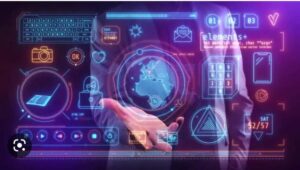Technology is a game changer
What a fantastic discussion to have at the conclusion of class about how AI technologies can improve education. As per normal, there was a pre-vote on whether people agreed or disagreed with the idea, and 31.6% said they did while 68.4% said they didn’t. However, by the end of the debate, 55.6% said they agreed while 44.4% said they didn’t. What changed? Both sides presented facts on the subject, and it became clearer that technology has the ability to revolutionize education with appropriate understanding and application.
WHAT IDEAS FOR THE PRE-VOTE AND POST-VOTE DID I SUPPORT?
I agreed with the idea because technology has improved my thought process and writing skills; with the use of Google Scholar and the URegina online library, I have found a lot of academic information online. Based on my experience in Nigeria and my new life in Canada, I have evolved positively with technology. Has the journey been simple? No! I learnt this the hard way because I began my master’s programme online during the Covid19 era. I had to spend a lot of time on assignments for a while learning how to create a PowerPoint presentation and give presentations online while maintaining my everyday responsibilities. I was exhausted and on the verge of giving up on my academic endeavours because I was new to all of the technology. But after eight classes in my master’s program, the proper use of educational technology was shown to me through multiple Zoom meetings by my professors and fellow students and the story has changed. I was able to understand the system’s operation thanks to all of this, and it changed everything for me.
TECHNOLOGY IN EDUCATION
I agree with the article (PDF) The Future of Education: Artificial Intelligence based Remote Learning because it highlighted the alternate patterns in learning platforms. With the use of digital learning tools and digital software, teachers can now track students’ progress and make learning more engaging and effective, technology has positively impacted education by enhancing how students learn. It has also made teaching easier for teachers. Additionally, regardless of geographic location, students can work together on projects, exchange ideas, and learn from one another by using online forums.
The application of AI in education helps in analyzing students’ data and offers teachers insights into student performance and potential areas in need of additional support. Curriculum and record keeping are improved as a result of this. As a result, the educator can spot potential red flags like kids at risk of dropping out or students having difficulty in a certain topic. This can assist schools in giving pupils who need it most specialized support and intervention.
AI has the potential to revolutionize education by helping to improve student/educator results and deliver personalized learning experiences. If used wisely, technology has the ability to improve learning and increase educational effectiveness.
FUTURE OF AI IN SCHOOLS
This section will begin with the negative impact of AI on education, emphasizing the points of the team that disagreed (George and Kanwal) with the debate’s topic. AI has the ability to revolutionise education in both positive and negative ways. One of the main worries regarding artificial intelligence in education is that it can result in a reliance on technology that is too great, which would lower the quality of human interaction and prevent the growth of interpersonal skills that are essential for success in the workplace. Additionally, because AI algorithms’ output is biased, it may result in differences in students’ academic performance and maintain existing inequities based on access to technology and education. Concerns about data privacy arise because AI algorithms need a lot of student data to function effectively.
However, all of these potentially harmful effects of AI in education can be reduced by ensuring that AI algorithms are transparent and unbiased and that they address issues with data privacy and accessibility.
The advancement of AI will help educators to design more individualized and efficient learning experiences for students, enabling more efficient and timely assessment for grading, record-keeping, and reporting. This opens up a world of opportunity for AI in education. Based on the most recent meeting with Dr Shelly, additional AI tools are currently being developed to ensure that new educational applications and tools are added to AI in technology to enhance learning experiences, make it transparent, and prevent plagiarism. The topic of the session, titled “The Evolution of Inclusion,” focused on how inclusion is changing and how we might integrate many inclusive frameworks to inform planning in ways that anticipate learners’ variability rather than retrofit for deficiencies. With chatbots like “ChatGPT”, and “AIgiarism,” tools such as GPTZero have been developed to potentially detect AI writing.
Overall, AI is only one aspect of technological development, the future of AI in schools is promising. However, it is crucial to make sure that it is implemented ethically and transparently. As with any technology, its aim is to save time and make output effective. AI in education should be utilized to support educators and revolutionize the teaching system to be better and not replace educators. The use of AI technologies in education would allow teachers and students to be creative and save time while also rethinking instructional methods in light of recent technological advancements. This will enhance student interaction and human connection.
In conclusion, the reality in the world currently is that technology here to stay ; it’s on our palm so how we utilize it is up to us.





Hi JR, Interesting perspectives on the topic. There can be few arguments regarding the benefits of AI in an ever-evolving world where technology is the driving force. My concern though is the dangers that come with it, especially by persons with less than noble intentions. Online scamming, identity theft, and online pedophiles are but some of the pitfalls we must consider as we enter this new phase of technological advancement…
I enjoyed that article about Edward Tian as well, JR. It was also wondering what Tian would say about his app, 3 months in. If 80,000 users accessed it in one week-ish, then how many have accessed it in these last three months? In another article about him he also talks about Pandora’s box that ChatGPT is opening, and it mirrors many of the things we have been talking about in class, and that were discussed in last week’s debate. I asked students to run their essays through ZeroGPT, and their reactions were quite telling – panic to confusion to ambivalence!